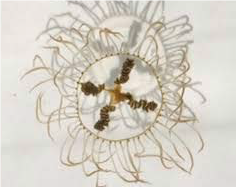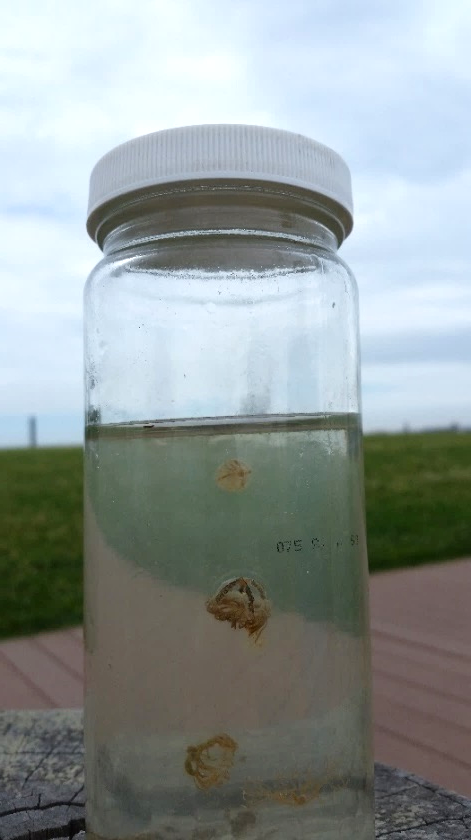DEP Extends Recreational Use Advisory on Clinging Jellyfish to Northern Barnegat Bay
DEP EXTENDS RECREATIONAL USE ADVISORY ON CLINGING JELLYFISH TO NORTHERN BARNEGAT BAY ADVISORIES ALREADY IN PLACE FOR METEDECONK, SHREWSBURY AND MANASQUAN RIVERS IN OCEAN AND MONMOUTH COUNTIES
(18/P055) TRENTON – The Department of Environmental Protection is advising recreational users of northern Barnegat Bay to exercise caution following confirmation of the presence of clinging jellyfish, a non-native species with a powerful sting, in this estuary that is popular for boating, fishing, swimming, crabbing and other recreational activities.
 The DEP and Montclair State University this week performed additional surveys in the northern bay and Metedeconk River after clinging jellyfish were confirmed in the river earlier this month. The Metedeconk flows into the northern bay.
The DEP and Montclair State University this week performed additional surveys in the northern bay and Metedeconk River after clinging jellyfish were confirmed in the river earlier this month. The Metedeconk flows into the northern bay.
In addition to advisories for northern Barnegat Bay and the Metedeconk River, the DEP reminds recreational users of the Shrewsbury and Manasquan rivers – Monmouth County waterways where the clinging jellyfish had been confirmed in recent years – to also be alert to its possible presence.
The clinging jellyfish is not known to inhabit ocean beaches or other sandy areas but tends to attach itself to submerged aquatic vegetation and algae in back bays and estuaries, areas not heavily used for swimming.
For a map of locations where clinging jellyfish have been confirmed and sites that have been investigated but no clinging jellyfish were found, click here.
The DEP and Montclair will be conducting additional monitoring in Barnegat Bay and the Metedeconk. There is no method to effectively control clinging jellyfish populations in the aquatic environment. The recent findings include locations in the bay off F Cove in Brick, and along Wardells Neck along the Metedeconk River, also in Brick.
The clinging jellyfish, a native to the Pacific Ocean, is small and very difficult to spot in the water. A sting can produce severe pain and other localized symptoms and can result in hospitalization in some individuals.
 The DEP encourages the public to use common sense and caution in areas where the jellyfish are suspected. Anyone wading through these areas, especially near aquatic vegetation, should take precautions, such as wearing boots or waders to protect themselves. Swimming at lifeguarded beaches is always encouraged.
The DEP encourages the public to use common sense and caution in areas where the jellyfish are suspected. Anyone wading through these areas, especially near aquatic vegetation, should take precautions, such as wearing boots or waders to protect themselves. Swimming at lifeguarded beaches is always encouraged.
The clinging jellyfish was first confirmed in New Jersey in 2016 in the Manasquan River at the Point Pleasant Canal. The DEP has been working with Montclair in studying the possible distribution of clinging jellyfish in New Jersey.
Sea nettles, another type of jellyfish with a less powerful sting, are common in Barnegat Bay but are much larger. They prey on clinging jellyfish. The clinging jellyfish ranges from the size of a dime to about the size of a quarter. It has a distinctive red, orange or violet cross across its middle.
Both the adult, or medusa, and polyp stages of the clinging jellyfish are capable of stinging, a mechanism the species uses to stun prey and to defend against predators. Each jellyfish can trail 60 to 90 tentacles that uncoil like sharp threads and emit painful neurotoxins. Tentacles grow to be about three inches long. Clinging jellyfish primarily feed on zooplankton.
If stung by a clinging jellyfish:
- Apply white vinegar to the affected area to immobilize any remaining stinging cells.
- Rinse the area with salt water and remove any remaining tentacle materials using gloves or a thick towel.
- A hot compress or cold pack can then be applied to alleviate pain.
- If symptoms persist or pain increases instead of subsiding, seek prompt medical attention.
Clinging jellyfish do not swim or migrate but can be spread by boats and in ballast. They were first observed in the eastern Atlantic at Woods Hole, Mass. By the 1920s, they had spread to other waterways in Massachusetts and Connecticut, likely through introduction by ship ballast or from Pacific oysters containing polyps.
If you see a clinging jellyfish, do not try to capture it. Take a photograph if possible and send it to Dr. Paul Bologna at bolognap@mail.montclair.edu or Joseph Bilinski at joseph.bilinski@dep.nj.gov along with location information.
For a fact sheet on clinging jellyfish, visit: www.nj.gov/dep/docs/clinging-jellyfish-factsheet.pdf
For a PowerPoint presentation on DEP clinging jellyfish research, visit: www.nj.gov/dep/docs/clinging-jellyfish-distribution.pdf
###
